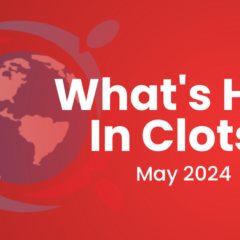Published on
What’s Hot in Clots – June 2023
Key Updates in Thrombosis
Table of Contents
- Electronic alerts to improve outpatient prescription of anticoagulation for AF
- Point-of-care biomarkers predict spontaneous reperfusion, as well as long-term MACE after STEMI
- ASH guidelines going more permissive on thrombophilia testing
- Antithrombotic therapy after left atrial appendage closure: What, when, and why?
Electronic alerts to improve outpatient prescription of anticoagulation for AF
Among outpatients with atrial fibrillation (AF) and CHA2DS2−VASc score ≥2 who were not on anticoagulation, an alert built into the electronic health record doubled the rate of anticoagulation within 48 hours (15.4% vs. 7.7%). Future studies are required to assess the results for lack of anticoagulation prescription (e.g., due to perceived or true high risk of bleeding), and to determine if such alert-based interventions can improve clinical outcomes if scaled to larger patient populations. Another issue is how to use the alerts seamlessly without causing “alert fatigue.” Read more
Point-of-care biomarkers predict spontaneous reperfusion, as well as long-term MACE after STEMI
In a prospective study of 801 patients with ST-elevation myocardial infarction (STEMI), point-of-care testing for occlusion times (OT) and endogenous lysis times (LT) were predictive of spontaneous reperfusion, defined as Thrombolysis in Myocardial Infarction (TIMI) flow grade 3 before PCI. Patients who had spontaneous reperfusion had a lower 4-year rate of major adverse cardiovascular events. Read more
ASH guidelines going more permissive on thrombophilia testing
The American Society of Hematology recently released guidelines for thrombophilia testing for venous thrombosis. While commending the expert group for the major undertaking, I find one point to be key in their summary: “Nearly all recommendations are based on very low certainty in the evidence due to modeling assumptions.” In other words, we need randomized controlled trials! The guidelines are being widely discussed by experts. One of the provocative recommendations was about provoked VTE, where a conditional recommendation was given for thrombophilia testing in “patients with VTE associated with non-surgical major transient or hormonal risk factors.” Read more
Antithrombotic therapy after left atrial appendage closure: What, when, and why?
In a comprehensive review, the authors share existing evidence and practical recommendations about the choice of agent and intensity of antithrombotic therapy for the early and late phases after left atrial appendage closure. Read more
Enjoy this update? Be sure to subscribe to get the latest updates each month.

Behnood Bikdeli, MD, MS
Cardiologist, Section of Vascular Medicine, Division of Cardiovascular Medicine, Brigham and Women’s Hospital
Investigator, Thrombosis Research Group, Division of Cardiovascular Medicine, Brigham and Women’s Hospital
Instructor, Harvard Medical School
Investigator, Yale/ YNHH Center for Outcomes Research and Evaluation, Yale School of Medicine
Investigator, Cardiovascular Research Foundation



